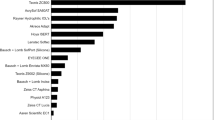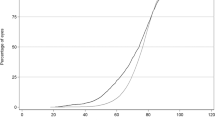Abstract
Background/Objectives
The aim of this study was to investigate whether the use of the silicone tipped irrigation/aspiration (I/A) handpiece CapsuleGuard® (Bausch + Lomb, Laval, Canada) reduced rates of posterior capsule rupture (PCR) during cataract surgery.
Methods
Royal College of Ophthalmologists’ National Ophthalmology Database (NOD) Cataract Audit data from 01/04/2010 and 31/03/2021 and Bausch + Lomb sales figures were combined to identify centres participating in national cataract audit who have routinely adopted the silicone tipped I/A handpiece, CapsuleGuard®. Data were included only from centres with eligible cataract operations recorded on the NOD both before and after adopting CapsuleGuard®. Review of the literature was undertaken to estimate the proportion of PCR that occurs during I/A, to evaluate the impact of adoption of CapsuleGuard® on PCR occurring in this phase of surgery.
Results
Within the study period, 267 371 eligible cataract operations were performed in 14 centres with >50 eligible operations both before and after adopting CapsuleGuard®. Within centres adopting CapsuleGuard®, the rate of PCR occurrence reduction was 16.4%. Before and after the adoption of CapsuleGuard® the median change of PCR was 21.7% reduction (IQR: 4.8% to 37.7% reduction).
Conclusions
A reduction in the rate of PCR was seen after regular adoption of CapsuleGuard® during cataract operations. Review of published studies attributing PCR to various components of the cataract operation suggest around 25% of PCR may occur during I/A; adoption of CapsuleGuard may, therefore, be associated with avoidance of a substantial proportion of the PCR during that phase of surgery.
This is a preview of subscription content, access via your institution
Access options
Subscribe to this journal
Receive 18 print issues and online access
$259.00 per year
only $14.39 per issue
Buy this article
- Purchase on Springer Link
- Instant access to full article PDF
Prices may be subject to local taxes which are calculated during checkout

Similar content being viewed by others
Data availability
The RCOphth NOD Cataract Audit data supporting the results reported in this article are available by application to the RCOphth; associated costs for data preparation and provision would be covered by those applying to access the data. Data used to identify centres utilising CapsuleGuard™ is commercially sensitive and not publicly available.
References
Cicinelli MV, Buchan JC, Nicholson M, Varadaraj V, Khanna RC. Cataracts. Lancet. 2023;401:377–89.
Low L, Shah V, Norridge CF, Donachie PH, Buchan JC, RCOphth NOD. Report 10: risk factors for post-cataract surgery endophthalmitis. Ophthalmology. 2023;130:1228–30.
Day AC, Donachie PHJ, Sparrow JM, Johnston RL. United Kingdom National Ophthalmology Database Study of Cataract Surgery: Report 3: Pseudophakic Retinal Detachment. Ophthalmology. 2016;123:1711–5.
Day AC, Donachie PH, Sparrow JM, Johnston RL. The Royal College of Ophthalmologists’ National Ophthalmology Database study of cataract surgery: report 1, visual outcomes and complications. Eye. 2015;29:552–60.
Stewart S, Gruszka-Goh MH, Neo YN, Braga AJ, de Klerk TA, Lindfield D, et al. The Royal College of Ophthalmologists’ National Ophthalmology Database Study of Cataract Surgery: Report 12, Risk factors for suprachoroidal haemorrhage during cataract surgery. Eye. 2023;37:1778–87. https://doi.org/10.1038/s41433-023-02514-y.
Foaud YA, Jabbehdari S, Neuhouser A, Soliman MK, Chandra A, Yang YC, et al. Visual Outcomes and Postoperative Complications of Eyes with Dropped Lens Fragments During Cataract Surgery: A Multicenter Database Study. J Cataract Refract Surg. 2023;49:485–91.
Ryburn C, Patnaik JL, Miller DC, Alexander J, Lynch AM, Davidson RS, et al. What Is the Cost of a Posterior Capsule Rupture Complication? Ophthalmic Surg Lasers Imaging Retin. 2020;51:444–7.
Cruz OA, Wallace GW, Gay CA, Matoba AY, Koch DD. Visual results and complications of phacoemulsification with intraocular lens implantation performed by ophthalmology residents. Ophthalmology. 1992;99:448–52.
Gimbel HV, Sun R, Ferensowicz M, Anderson Penno E, Kamal A. Intraoperative management of posterior capsule tears in phacoemulsification and intraocular lens implantation. Ophthalmology. 2001;108:2186–9.
Osher RH, Cionni RJ. The torn posterior capsule: its intraoperative behavior, surgical management, and long-term consequences. J Cataract Refract Surg. 1990;16:490–4.
Ti SE, Yang YN, Lang SS, Chee SP. A 5-year audit of cataract surgery outcomes after posterior capsule rupture and risk factors affecting visual acuity. Am J Ophthalmol. 2014;157:180–5.e1.
Thanigasalam T, Sahoo S, Ali MM. Posterior capsule rupture with/without vitreous loss during phacoemulsification in a hospital in Malaysia. Asia Pac J Ophthalmol. 2015;4:166–70.
Bai H, Yao L, Wang H. Clinical investigation into posterior capsule rupture in phacoemulsification operations performed by surgery trainees. J Ophthalmol. 2020;2020:1317249.
Benjamin L. Fluidics and rheology in phaco surgery: what matters and what is the hype? Eye. 2018;32:204–9.
Lockington D, Macente A, Marrocco T, Sillars F. Novel internal analysis of metal irrigation/aspiration tips could explain mechanisms of posterior capsule rupture. Eye. 2021;35:1915–21.
Barros MG, Osher RH. Posterior capsule tear caused by misalignment within a silicone irrigation/aspiration tip. J Cataract Refract Surg. 2004;30:1570–1.
Hart JC Jr., Tanner M, Rooney DM. Electron microscopy of silicone irrigation/aspiration tips involved in posterior capsule rupture. J Cataract Refract Surg. 2018;44:1517–20.
Blomquist PH, Pluenneke AC. Decrease in complications during cataract surgery with the use of a silicone-tipped irrigation/aspiration instrument. J Cataract Refract Surg. 2005;31:1194–7.
Maubon LG, Ursell PG. Reduced posterior capsular rupture rate observed among trainee surgeons utilizing a disposable silicone-tipped irrigation and aspiration handpiece for soft lens removal. Expert Rev Ophthalmol. 2018;13:293–7.
Acknowledgements
It is with gratitude that we remember our friend and colleague Robert Johnston, who sadly died in September 2016. Without his inspirational vision, determination and career long commitment to quality improvement in ophthalmology this work would not have been possible. We acknowledge the support of the hospitals that participated in this National Ophthalmology Database Audit study and thank our medical and non-medical colleagues for the considerable time and effort devoted to data collection. The participating centres included in this study are listed in alphabetic order below: Barking, Havering and Redbridge University Hospitals NHS Trust; Bradford Teaching Hospitals NHS Foundation Trust; East Kent Hospitals University NHS Foundation Trust; Epsom and St Helier University Hospitals NHS Trust; Hampshire Hospitals NHS Foundation Trust; Leeds Teaching Hospitals NHS Trust; Liverpool University Hospitals NHS Foundation Trust; Manchester University NHS Foundation Trust; Mid Cheshire Hospitals NHS Foundation Trust; Mid Yorkshire Teaching NHS Trust; Royal Devon University Healthcare NHS Foundation Trust; South Warwickshire University NHS Foundation Trust; University Hospitals Coventry and Warwickshire NHS Trust; Wirral University Teaching Hospital NHS Foundation Trust.
Funding
The analysis in this study was funded by Bausch + Lomb, however the data collection from centres, analysis and write up was independent of Bausch + Lomb. No editorial rights were assigned to Bausch + Lomb and the commitment to publish the findings regardless of the direction of results was established by the authors prior to commencement. The RCOphth National Ophthalmology Database Cataract Audit is currently funded through participation fees from centres as well as unrestricted financial contributions from Alcon and Bausch + Lomb.
Author information
Authors and Affiliations
Contributions
All authors discussed the original idea regarding how to evaluate the introduction of new technology to UK cataract service provision using NOD data; JB, CN and PD developed the details of the data collection and analysis plan. CN and PD undertook statistical analysis and JB led the writing of the paper with all authors discussing conclusions and reviewing the final manuscript.
Corresponding author
Ethics declarations
Competing interests
The authors declare no competing interests.
Additional information
Publisher’s note Springer Nature remains neutral with regard to jurisdictional claims in published maps and institutional affiliations.
Rights and permissions
Springer Nature or its licensor (e.g. a society or other partner) holds exclusive rights to this article under a publishing agreement with the author(s) or other rightsholder(s); author self-archiving of the accepted manuscript version of this article is solely governed by the terms of such publishing agreement and applicable law.
About this article
Cite this article
Buchan, J.C., Norridge, C.F.E., Barnes, B. et al. The Royal College of Ophthalmologists’ National ophthalmology database study of cataract surgery: Report 14, cohort analysis – the impact of CapsuleGuard® utilisation on cataract surgery posterior capsule rupture rates. Eye (2024). https://doi.org/10.1038/s41433-024-03003-6
Received:
Revised:
Accepted:
Published:
DOI: https://doi.org/10.1038/s41433-024-03003-6



